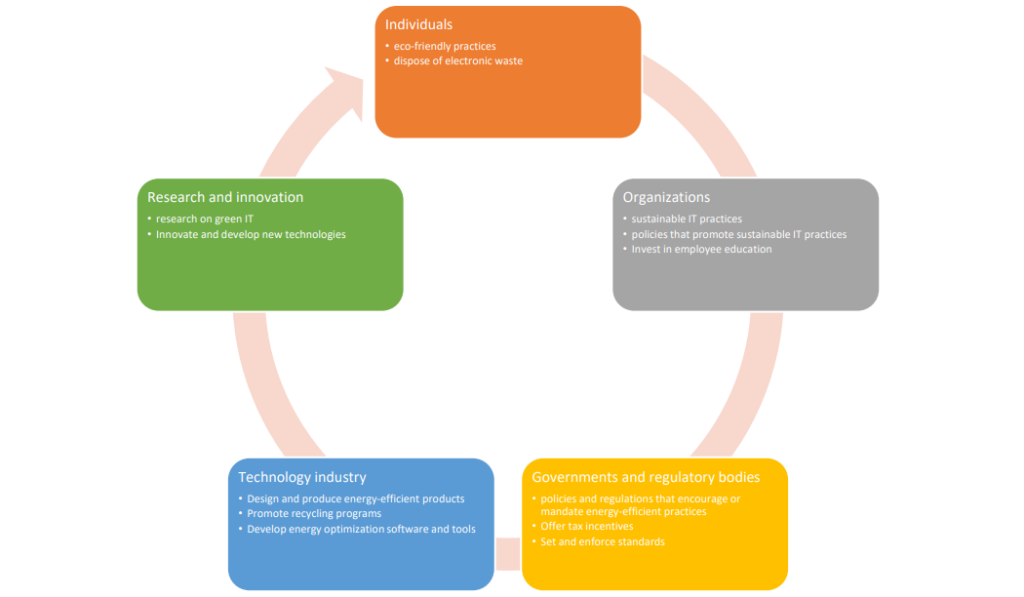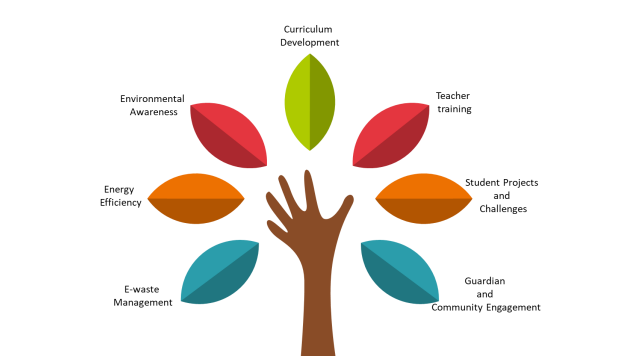What is Green IT?
Green IT, also known as sustainable IT or ICT sustainability, is the practice of designing, manufacturing, using, and disposing of IT products and services in a way that minimises their environmental impact. This includes reducing energy consumption, greenhouse gas emissions, and e-waste [1].
Green IT practices can be implemented at all levels of an organisation, from the data center to the individual user. Some examples include:
- Using energy-efficient hardware and software
- Reducing power consumption by powering down devices when they are not in use
- Using renewable energy sources to power data centers
- Implementing virtualization and cloud computing to reduce the number of physical servers
required - Recycling and disposing of e-waste responsibly.
Why Green IT is so important?
A report from the Association for Computing Machinery [2] emphasises the urgent need for substantial reductions in energy consumption and carbon emissions within the computing and ICT sector to effectively mitigate climate change and prevent severe environmental consequences. Green IT is therefore important for several reasons:
- Environmental Conservation: Green IT helps reduce the environmental impact of information technology systems. The IT industry is a significant contributor to electronic waste (e-waste), energy consumption, and carbon emissions. By adopting eco-friendly practices, we can mitigate these negative effects. To have an idea of the volume of e-waste, in 2020, 10.3 kilos of electrical and electronic equipment waste were collected per inhabitant in the EU [3].
- Energy Efficiency: Data centres and IT infrastructure consume vast amounts of energy. Green IT initiatives, such as virtualisation, energy-efficient hardware, and improved cooling techniques, can significantly reduce energy consumption, leading to lower electricity bills and a smaller carbon footprint. It has been calculated that data centres and data transmission networks are responsible for 1% of energy-related GHG emissions [4].
- Resource Conservation: The production of electronic devices requires the extraction of precious and often non-renewable resources. Extending the lifespan of IT equipment through efficient maintenance and recycling reduces the demand for these resources.
- Cost Savings: By optimising energy usage and reducing waste, organisations can achieve cost savings. This includes lower electricity bills, reduced hardware replacement costs, and potential tax incentives for adopting green technologies.
- Sustainable Growth: Embracing Green IT is an essential component of sustainable business practices. It demonstrates a commitment to reducing the organisation’s ecological footprint, which can enhance reputation and attract environmentally conscious customers and partners.
- Innovation and Competitiveness: Green IT encourages innovation in technology development and design. Companies that invest in sustainable technologies can gain a competitive edge in the marketplace and attract environmentally conscious customers.
- Global Responsibility: IT is a global industry, and its impact on the environment affects people worldwide. By adopting green practices, organisations can contribute to global efforts to combat climate change and reduce ecological harm.
In summary, Green IT is crucial for reducing the environmental impact of information technology, cutting costs, complying with regulations, and positioning organizations as responsible, forward thinking entities in a world increasingly focused on sustainability and environmental conservation.
Green IT Stakeholders: Working Together for a Sustainable Future
Stakeholders for Green IT are numerous and include individuals, organisations, governments, and the technology industry. Here’s a breakdown of the responsibilities of each group:
Individuals
- Individuals can adopt eco-friendly practices in their personal technology usage, such as turning off devices when not in use, reducing screen brightness, and using energy-efficient settings.
- Properly dispose of e-waste by recycling or donating old devices rather than discarding them in landfills.
- Individuals can also use renewable energy to power their personal devices, such as solar-powered chargers for their phones and laptops.
Organisations
- Businesses and institutions are responsible for implementing sustainable IT practices within their operations. This includes adopting energy-efficient hardware and software, optimising data centre operations, and practicing responsible e-waste management.
- Developing and enforcing policies that promote sustainable IT practices among employees.
- Investing in employee education and training on Green IT principles.
Government and Regulatory Bodies
- Governments can enact policies and regulations that encourage or mandate energy-efficient practices in the IT industry.
- Governments can also develop green IT standards for products and services, which can help to reduce the environmental impact of the IT industry.
- Offering tax incentives or subsidies for organisations that adopt environmentally friendly technologies.
- Setting and enforcing standards for electronic waste recycling and disposal.
Technology Industry
- Hardware and software manufacturers play a significant role in Green IT by designing and producing energy-efficient products.
- Hardware and software manufacturers can also design products with end-of-life disposal in mind, to make it easier to recycle or reuse them.
- Promoting recycling programs for electronic devices and components.
- Developing software and tools that help monitor and optimise energy consumption
Research & Innovation
- Research institutions and academia can contribute by conducting research on Green IT technologies and practices to advance the field.
- Innovating and developing new technologies that are more energy-efficient and environmentally friendly.
Consumers
- Consumers have the power to influence the technology market by choosing to purchase products and services from companies that prioritise sustainability.
- Supporting companies that have transparent and responsible supply chain practices.

In summary, Green IT is a collective responsibility that involves individuals, organisations, governments, the technology industry, and various stakeholders working together to reduce the environmental impact of information technology and promote sustainability. Each group has a role to play in advancing and implementing Green IT practices.
Green IT Education
Green IT education is important for several reasons, as it addresses the growing need for sustainability in the information technology sector and the ever increasing level of digitalisation in almost all sectors of human activity and digital literacy of people.
Environmental Awareness: Green IT education helps individuals and organizations understand the environmental impact of information technology, including energy consumption, electronic waste, and carbon emissions. This awareness is crucial for making informed decisions and taking responsible actions.
- Resource Conservation: By teaching green IT principles, education promotes the efficient use of resources, such as energy and materials. This leads to reduced resource consumption and a smaller ecological footprint.
- Cost Savings: Green IT practices often result in cost savings. Educating individuals and organisations about these practices can help them reduce energy bills, extend the lifespan of IT equipment, and lower operational costs.
- Sustainable Business Practices: In today’s environmentally conscious world, businesses that embrace sustainability are more attractive to customers, partners, and investors. Green IT education equips professionals with the knowledge and skills to integrate sustainable practices into their organisations, enhancing competitiveness and reputation.
- Innovation and Technology Advancement: Green IT education encourages innovation in technology design and development. Educated professionals are more likely to create and adopt eco-friendly technologies, driving advancements in the field.
- Compliance and Regulation: Many regions have environmental regulations and standards that affect the IT industry. Education ensures that organisations stay compliant with these regulations, avoiding legal issues and penalties.
- E-waste Management: Green IT education teaches individuals and organisations how to responsibly manage e-waste, including recycling and proper disposal. This reduces the negative impact of
e-waste on the environment. - Global Responsibility: Information technology is a global industry, and its impact on the environment extends worldwide. Green IT education instils a sense of global responsibility, as individuals and organisations recognise their role in mitigating climate change and reducing ecological harm.
- Energy Efficiency: Educated IT professionals can implement energy-efficient practices and technologies, leading to lower energy consumption and a reduced carbon footprint. This is especially important as energy demands continue to rise.
- Job Opportunities: As sustainability becomes a priority for businesses and governments, there is a growing demand for professionals with expertise in green IT. Education in this field can open up job opportunities and career growth prospects.
- Resilience: Green IT education can help organisations build resilience against environmental and regulatory risks. Being prepared for changes in environmental regulations and market preferences is essential for long-term viability.
In short, Green IT education is vital for promoting sustainability, reducing environmental impact, and ensuring the responsible use of technology. It empowers individuals and organisations to make informed choices that benefit both the planet and their bottom line. As the IT industry continues to evolve, green IT education will play a crucial role in shaping its future.
Integrating Green IT Education into K12 schools
Green IT Education is essential for cultivating environmental awareness and sustainable technology practices from an early age. Here are key steps and strategies for incorporating green IT education in K-12 schools [6,7]:
Curriculum Development
- Collaborate with educators, curriculum developers, and environmental experts to create age-appropriate Green IT curriculum materials.
- Develop lesson plans and activities that align with existing subjects, such as STEM and social studies.
- Develop age-appropriate content to ensure that the content is age-appropriate and engaging for students of all ages. Use storytelling, games, and real-world examples to make Green IT concepts relatable.
Teacher Training
- Provide training and professional development opportunities for teachers to equip them with the knowledge and resources needed to effectively teach Green IT concepts.
- Encourage teachers to share best practices and educational resources related to Green IT.
Environmental Awareness
- Introduce students to the environmental challenges associated with IT, such as electronic waste, energy consumption, and carbon emissions.
- Discuss the global and local impact of IT on the environment.
Energy Efficiency
- Teach students about energy-efficient computing practices, such as turning off devices when not in use, optimizing device settings, and using renewable energy sources.
- Calculate energy savings and carbon footprint reductions as part of classroom activities.
E-waste Management
- Explain the importance of responsible e-waste disposal and recycling.
- Organise e-waste collection events or partnerships with local recycling centres to involve students in practical e-waste initiatives.
Student Projects and Challenges
- Organize Green IT projects and challenges where students can propose and implement sustainable technology solutions within their school or community.
- Recognise and reward student initiatives in green technology.
Guardian and Community Engagement
- Involve guardians and students in community-based environmental projects and collaborations with local organizations and businesses.
- Encourage students to share their knowledge and promote Green IT practices within their communities

By incorporating these key steps and strategies, K12 schools can empower students with the knowledge and skills needed to become responsible stewards of technology and contribute to a more sustainable future.
Authors: Panos Fitsilis [fitsilis(at)uth.gr], Vyron Damasiotis [damasiotis(at)uth.gr]; University of Thessaly.
References
- IBM, What is green computing? Available at https://www.ibm.com/blog/green-computing/
- European Parliament, E-waste in the EU: facts and figures, Available at https://www.europarl.europa.eu/news/en/headlines/society/20201208STO93325/e-wastein-the-eu-facts-and-figures-infographic
- International Energy Agency, Tracking Data Centres and Data Transmission Networks, https://www.iea.org/energy-system/buildings/data-centres-and-data-transmissionnetworks
- Computing and Climate Change, Association for Computing Machinery, Available at https://dl.acm.org/doi/pdf/10.1145/3483410
- UNESCO, Guidebook on education for sustainable development for educators. Available at https://unesdoc.unesco.org/ark:/48223/pf0000367474
- US Environmental Protection Agency. Energy Efficiency Programs in K-12 Schools. Available at https://www.epa.gov/sites/default/files/2015-08/documents/k-12_guide.pdf
- Park, N.-E., Choe, S.-U., & Kim, C.-J. (2020). Analysis of Climate Change Education (CCE) Programs: Focusing on Cultivating Citizen Activists to Respond to Climate Change. Asia Pacific Science Education, 6, 1–26. doi:10.1163/23641177-BJA00004


